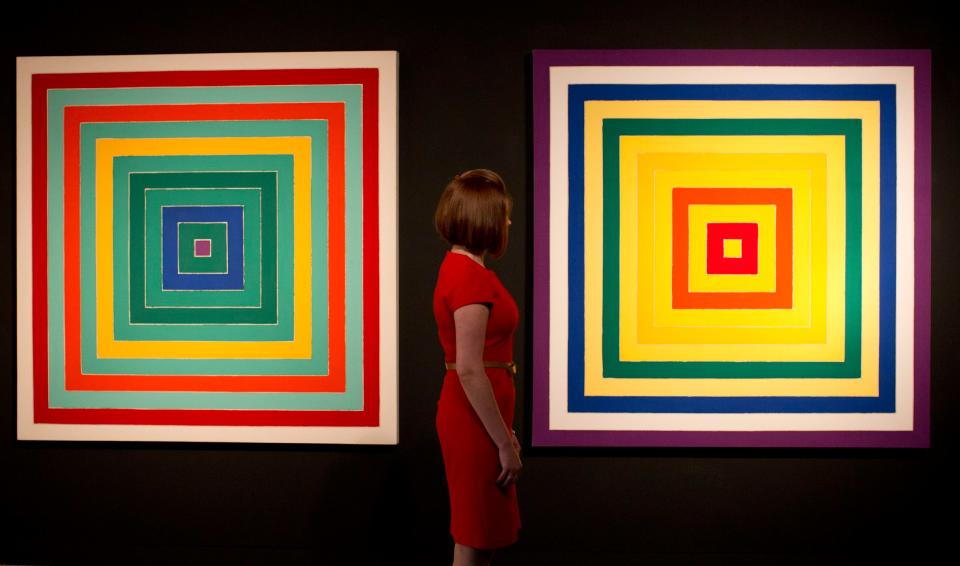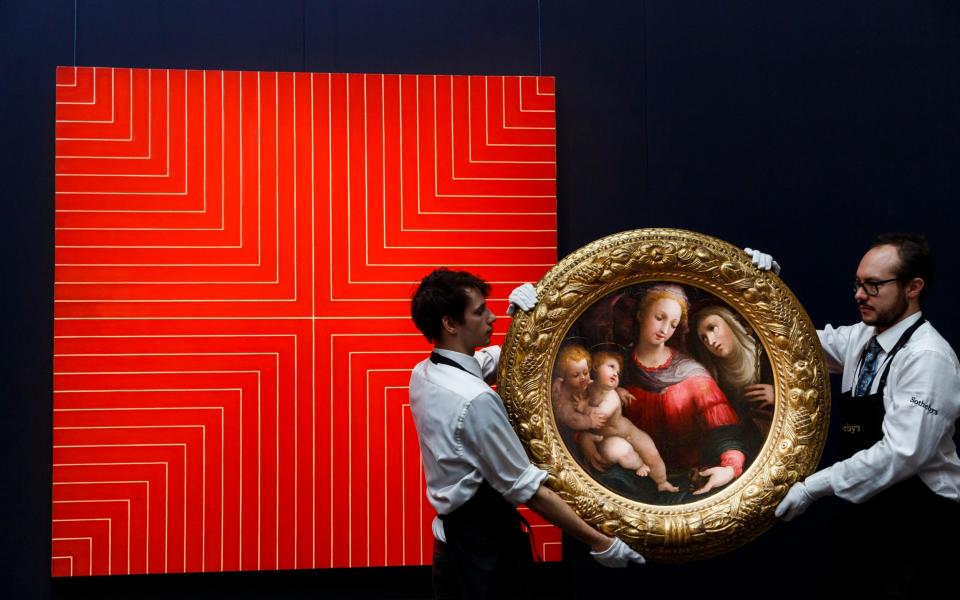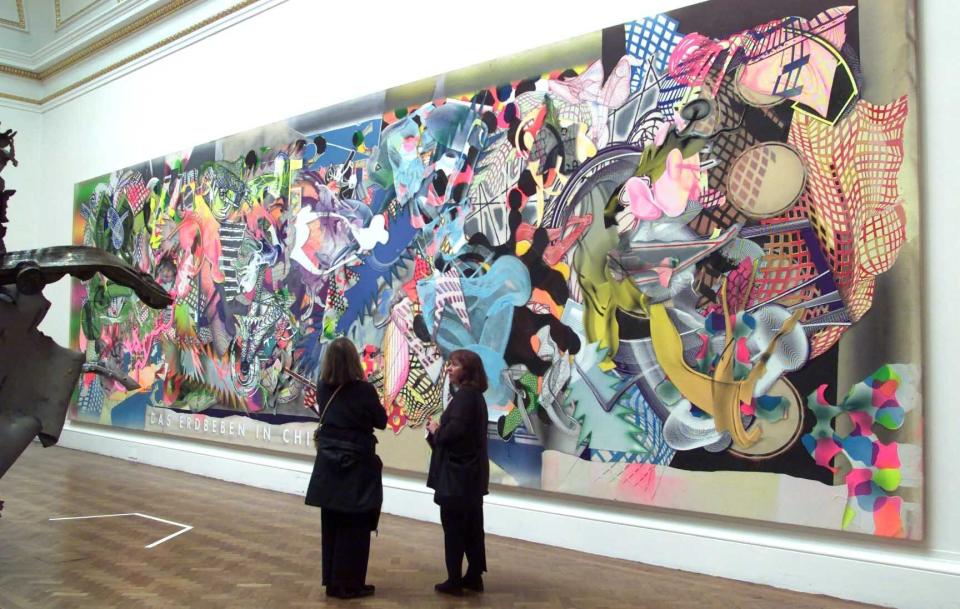Frank Stella, the American artist who died at the age of 87, remained a leader in the field of abstract art for more than half a century; his work was seen as a harbinger of future developments from the moment he entered the New York art scene at the age of 23.
Stella began his career in the 1950s with work in the style of the Abstract Expressionists, but his breakthrough came after the debut solo exhibition of the American artist Jasper Johns, which sold out at the Leo Castelli Gallery in New York in early 1958. Intrigued by the red and white bands of Johns’ paintings of the American flag, Stella began experimenting with his own colorful stripes.
He started working on a painting he called Delta, “and I remember getting mad at it. So I painted over it and went to bed. When I looked at it the next day, it didn’t look that bad. All I had done was simplify it by painting the tires completely black. But something happened. It had a kind of presence. That was the beginning.”

Delta started the Black Paintings series that made Stella’s name and remains his best-known works: large, aggressive canvases covered with streaks of black enamel paint that formed repetitive, undulating patterns. In 1959, four of the Black Paintings were included in the important Sixteen Americans exhibition at the Museum of Modern Art, alongside works by Johns and Robert Rauschenberg. Gloomy and enchanting, with disturbing titles such as Reichstag and Arbeit Macht Frei, the paintings took Manhattan by storm. Stella was only 23. The following year he had his first solo exhibition at the Leo Castelli Gallery.
Over the next decade, Stella produced series after series of abstract paintings. Stripes became his signature. He used them as a basis for complex geometric designs; placed them on canvases that formed unusual shapes and painted them with flat house paint instead of oil.
Those looking for “meaning” were told not to worry about it. The painting was the object, he insisted, and he rejected the idea that art could be a vehicle for the expression of greater truths. “What you see is what you see,” he declared in 1964. As his friend, the sculptor Carl Andre, once wrote, “His strokes are the path from brush to canvas.” His goal, Stella said, was “to keep the paint as good as it was in the can.”
Stella’s paintings did much to end the dominance of Abstract Expressionism and usher in Minimalism – so much so that he was often referred to as the ‘father’ of Minimalism. But from the late 1960s Stella began to change from a minimalist preoccupation with flatness and the suppression of illusion. His paintings became more complex in structure, color and shape. Later he removed them from the wall to create bold sculptural forms, with titles that evoked associations with external phenomena.
This change began with a monumental series of 44 asymmetrical canvases, the “Irregular Polygons,” in which Stella’s signature stripes gave way to vast fields of lush color and the paintings took on an autobiographical touch, named after New Hampshire towns where the young Stella had been on fishing trips with his father.
These paintings secured Stella’s position at the forefront of the avant-garde and eventually earned him his first retrospective at the Museum of Modern Art in 1970, when he was 33, making him the youngest artist to be honored in this way by MoMA (almost twenty years later, in 1987, he became the only living artist to have a second retrospective at the institution.


But his change in outlook came to full expression in the 1970s and 1980s, when he developed a much freer, more expansive idiom that paved the way for the neo-expressionist artists and graffiti artists. His series ‘Brazilian’ and ‘Exotic Birds’, with their dense profusion of flowery shapes, bright colors and surfaces decorated with glitter, captured the atmosphere of an era that had all but turned its back on the formalist abstraction of the 1960s. It was anything but minimal.
Stella provided a theoretical justification for this turn in 1983 when he was invited to deliver the Norton series of lectures on art at Harvard. In preparation for the lectures, he decided to revisit the Old Masters and became fascinated by Caravaggio’s John the Baptist: “Until then I had not been able to identify with the Old Masters, because for me the past began with Manet,” he recalls .
But Caravaggio’s work influenced him deeply: “After seeing his work, I felt reaffirmed in every way about what I wanted to do. I want my paintings and the work I make to have that kind of immediacy. I want it to be ‘real’, like Caravaggio’s painting is real.”


In his lectures he offered a broad critique of the minimalist style he had done so much to promote. “The most highly regarded, shallow painting of the past fifteen years,” he declared, had been “excruciatingly dull and unpromising.” In contrast, Caravaggio’s dramatic foreshortenings and busy foregrounds suggested both perspective and the extension of the action beyond the frame into the viewer’s space. This was exactly what modern painting needed, he said.
His earlier work, he later suggested – “all that cleverness and fussing about it” – was “a kind of hiding from the fact that I was somehow not acceptable and that my feelings were not that acceptable”. But his volte face never seemed to bother him: ‘There is a power in the striped paintings that the newer ones will never have. On the other hand, there is an energy in the newer works – a kind of flowery excitement – that the stripe paintings did not have. I don’t think you can do that in one go. That’s why you’re lucky to have a whole life.”
Frank Philip Stella was born on May 12, 1936, the son of first-generation Sicilian immigrants, and grew up in Malden, a working-class neighborhood of Boston. His father, a gynaecologist, sent him to Phillips Academy, Andover, where he gained a reputation for fearlessness (he once lost three front teeth in a dormitory). As a child, he never dreamed of becoming an artist: “My parents believed that artists were perhaps slightly better than pimps.” But at Princeton University, where he studied history, he took an evening course in painting and drawing and discovered his calling.
After graduating in 1958, he moved to New York, where he soon shared a loft studio on West Broadway with Carl Andre and the photographer Hollis Frampton.


Stella’s paintings could fetch millions of dollars, but he did not consider himself wealthy, partly because he had expensive taste. He loved fast cars and bred racehorses as a hobby.
Stella, a rumpled New York man with thick, wavy hair and a high-pitched voice (some say reminiscent of Joe Pesci in Goodfellas), had a reputation for being so fiercely competitive that his friends eventually refused to play tennis with him. Gallery director Lawrence Rubin, who gave Stella his second solo exhibition in Paris in 1961, once said: ‘He doesn’t play for the fun of playing. He plays to win. And that’s the way he plays art.”
In 2009, he received the National Medal of the Arts from President Obama.
In 1961 Stella married the art historian Barbara Rose, with whom he had a daughter and a son. The marriage was dissolved in 1968. He married Harriet McGurk, a pediatrician, in 1978, with whom he had two sons.
Frank Stella, born May 12, 1936, died May 4, 2024